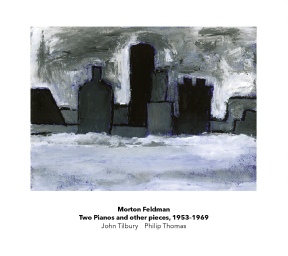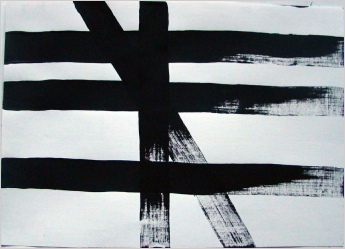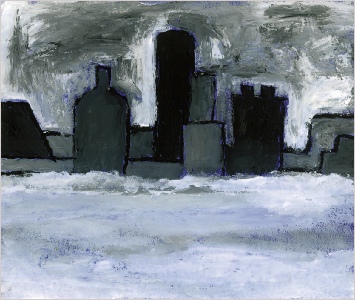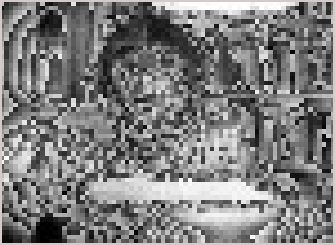Another Timbre TimHarrisonbre

at81x2 Morton Feldman - Two Pianos and other pieces 1953-1969
A double CD of music for multiple pianos from what is arguably the most experimental and interesting period of Morton Feldman’s development as a composer. Some of the pieces have been very rarely performed or recorded, and have probably never been in better hands.
John Tilbury, Philip Thomas, Catherine Laws & Mark Knoop - pianos
Anton Lukoszevieze & Seth Woods - cellos
Mira Benjamin & Linda Jankowska - violins
Rodrigo Constanzo & Taneli Clarke - percussion
Barrie Webb - trombone
Naomi Atherton - horn
Youtube extract - False Relationships and the Extended Ending
Paintings by Denis Sorokin

Notes on Morton Feldman’s ‘Two Pianos and other pieces’ by Philip Thomas
The music featured on these two discs testifies to the intensity of Feldman’s experimentation with notation and sound during the 1950s and 60s. Considering the works chronologically one senses the composer trying out, teasing and developing means of notation to get close to his desired elasticity of time and duration. His experiments with indeterminacy of pitch – whereby Feldman specified only the register (high, middle, low) of sound rather than the exact notes themselves – do not feature here; after trying this method in a series of works in the early 1950s he abandoned the technique, with a few notable exceptions straying into the 1960s, because he was too ‘attached’ to the pitches he wanted.
All notes are specified exactly in the pieces on these discs – the experiments are instead with duration and time. Durations of sounds are variously free, dependent upon the decay of the sound, worked out in coordination with other players, as well as at times exactly and complexly notated within a specific tempo. Sometimes the freedoms of notating time are worked through in combination with listening closely to the sounds of other players, allowing patterns to emerge without forcing the situation, whilst at other times different ways of notating time are combined, creating false alignments in the score and thus placing greater emphasis upon the individual performer’s journey.
The piano is an inherently indeterminate instrument - any given note will have a very different afterlife dependent upon the touch of the performer, the register of the note, the type and size of the piano, the acoustic of the space in which the piano is situated, and so forth. Put six or seven of these notes together as a chord and the situation becomes complex. In all these pieces Feldman specifies the dynamics to be quiet, or as quiet as possible, or very quiet. However the notion that Feldman’s music is ‘about’ quiet-ness is a misconception: the subject is sound, and in order for that subject to be properly attended to those sounds are quiet. The range of pieces presented here depict very many different types of quietness – from the delicate sounds of Piano Three Hands and Piano Four Hands to the massed complexities of Two Pieces for Three Pianos. Quietness in Feldman’s piano music is a performance instruction which is everything to do with touch and the desire to really hear the instrument. As such these recordings are a celebration of the piano (its tone and its decay) and piano playing, for all its frustrations and challenges – an instrument which is at the heart of Feldman’s music.
The earliest work recorded here is Intermission 6 (1953), for one or two pianos. The score consists of a single page of music across which are scattered fragments: single notes, chords, the occasional ‘grace’ note, using the range of the keyboard, all redolent of Feldman’s harmonic and pitch sensibility. The performers move through these in any order, a rare freedom within Feldman’s music, and one which he was not to make use of again.
Piece for 4 pianos (1957) introduces a notational and formal procedure which proved to be considerably more fruitful, influencing works composed even twenty years later. All four pianists read from the same single page of score but move through it at their own pace. Thus the sequence of sounds remains constant but the duration of each sound is entirely free (within the parameter of ‘slow’). The resultant shimmering effect, as the four pianists variously play the same chord, sometimes with reiterations, pre-empts aspects of later minimalism, and indeed the performance process is not entirely dissimilar from that of Terry Riley’s In C composed a mere seven years later.
Two Pianos (1957) and Piano Four Hands (1958) were composed within eighteen months of Piece for 4 pianos. The former follows exactly the same procedure as Piece for 4 pianos whilst Piano Four Hands assigns different material to each pianist, but maintains the principle of moving through the material independently. Piano Three Hands, also composed in 1957, is distinct, consisting of regular, albeit slow, moving events, recalling an earlier work for solo piano, Piano Piece 1952.
A group of five works, each with the title Durations, composed during 1960-61, explore this compositional device further and to great effect. Yet at the same time Feldman was exploring other ways of dealing with duration and time, perhaps the result of unsatisfactory performances of these other works. In solo works he investigated options for making use of stemless noteheads, combined with pauses, to obtain a music free of metred time, though in some works combining this technique with more strictly notated music, as if to compare resultant performances of both notations.
In ensemble works he combined the stemless noteheads with a means of notating sequences of sounds in relation to other instruments, so that the end of one instrument’s sound cues the beginning of another instrument’s sound. It is quite possible that Feldman was in this way influenced by the new ‘cue-ing’ notations of his friend Christian Wolff, in pieces such as Duet II (1961) and For Five or Ten People (1962). Works featured on these recordings notated in this way are De Kooning (1963), Vertical Thoughts I (1963) and Four Instruments (1965), each of which are characterised by a sparseness of sound due to the predominance of sounds played in sequence rather than as vertical masses.
Two Pieces for Three Pianos (1966) is a transitional and quite remarkable work. The first piece combines two different notation types: the first and second pianos read only stemless noteheads, with the instruction to play each event once the decay of the previous event has begun; the third piano part is fully notated with very precise durations, metre and ever-changing tempi. Each player follows their own part dogmatically – there is very little room for listening and responding to the other players. The texture is extremely dense, consisting of predominantly thick chromatic chords in all three pianos which gradually thin out toward the end of the piece. There is no coordination and the piece thus ends sparsely as the pianos ‘drop out’ and the first two pianists play high and delicate events. The second piece is more coordinated, mostly using the form of notation and sequence used in Vertical Thoughts I, combining stemless noteheads with occasional metred and rhythmically precise notation.
False Relationships and the Extended Ending (1968) and Between Categories (1969) are perhaps the two most extraordinary works featured here if considering the notational characteristics alone. Feldman divides the ensemble into two smaller ensembles: violin/trombone/piano and cello/chimes/2 pianos (toward the end subdivided further as chimes/piano and cello/piano) in False Relationships…; and two equal ensembles of violin/cello/chimes/piano in Between Categories. The two ensembles in both pieces follow a mixture of notations, variously strictly notated, with changing tempi, and stemless noteheads, played in sequence and as simultaneities. Whilst the ensembles are notated synchronously on the page, one above the other, at any point in time one ensemble may actually be reading from one, two or possibly three pages apart from the other. Even when both ensembles look on the page as if they are notated similarly, with matching bar lines, on closer look the reader will notice that the time signatures and tempi markings of one ensemble are entirely different from the other. It is as if Feldman is playing some kind of visual game which bears no relation to the aural result. However, the music is very carefully thought out, and where one ensemble appears to be significantly adrift from the other in terms of the notated score, it is more than likely that the gap will close at some later point and the ensembles become more aligned aurally. Whilst none of this is apparent to the listener, at the same time it is clear that there are some very definite periods of harmonic synchronicity, and other times where the ensembles feel to be quite separate. Likewise, certain ideas and pitches are tossed between ensembles, giving the impression of precisely coordinated events when in actuality the detail of such imitative patterns is the result of performance-based chance, albeit one which occurs within a meticulously planned framework.
Feldman was not to return to these techniques. The works which followed, in the early 1970s, are more traditionally and simply notated, serving different compositional aims and agendas. The complexity of these late 1960s works is echoed in the extraordinary and bafflingly notated works of the late 1970s and early 1980s. Feldman’s experiments with notation, decay, duration and ensemble continued until the end of his life, but always with an attentive ear and technical mastery which heightens the ungraspable and transitory qualities of sound.
Philip Thomas, October 2014
You can read more thoughts about the pieces on the double CD in Philip’s blog post here
““The magic is to make sounds out of pitches” Morton Feldman suggested in Darmstadt in 1984. To grasp what that might mean in practice, simply listen to ‘Piece for Four Pianos’ played by John Tilbury, Philip Thomas, Catherine Laws and Mark Knoop. This composition from 1957 is notated as to pitch, but Feldman left it open to performers to take the same single page score at their own chosen pace, allowing the mercurial qualities of personal touch, sensitivity to each note’s decay, the acoustic properties of the hall, idiosyncrasies of a particular instrument and other factors unspecified by the composer to work audible magic. Tilbury and Thomas act as the hub for this entire collection, combining their distinct yet equally refined interpretative identities in a series of duets, and within mixed chamber groups involving fine musicians such as cellist Anton lukoszevieze and violinist Mira Benjamin. These exploratory works, from Intermission 6 (1953) to between Categories (1969), form a compendium of spellbinding sounds.”
Julian Cowley, The Wire, February 2015
“Eine der schönsten, um nicht zu sagen: betörendsten Alben mit Musik von Morton Feldman ist kürzlich beim auf kontemplative Raritäten spezialisierten Label Another Timbre erschienen. Der erfahrene Feldman-Interpret John Tilbury hat zusammen mit dem Pianisten Philip Thomas und weiteren Instrumentalisten die Werke für mehrere Klaviere bzw. Klavier zu drei bis vier Händen und Kammermusik mit Klavierbeteiligung aufgenommen. Das Doppelalbum versammelt eine Reihe von Stücken, bei denen Feldman mit verschiedenen Notationsformen experimentiert. Während die Tonhöhen bzw. die Harmonik (Akkordik) genau fixiert ist, können die Dauern mehr oder weniger frei von den Interpreten gestaltet werden.
Feldman wollte die Klänge befreien; sie sollten nicht mehr irgendetwas darstellen (keinen "Ausdruck", auch keine vorkomponierte Struktur), sondern einfach sie selbst sein in ihrer Sinnlichkeit und Schönheit und geheimnisvollen Atmosphäre. Die Klänge sollen aus der Stille hervortreten, atmen, schweben und wieder in die Stille zurückkehren können. Feldmantypisch ist die extrem leise Dynamik und subtile Artikulation, weiter die abstrakte Statik zarter und zartester Klangobjekte.
Aufgrund seiner reichen Resonanzräume und differenzierten Klangerzeugung, bei der ein minimal veränderter Anschlag schon einen neuen Klang hervorbringt, ist das Klavier das Feldman-Instrument schlechthin. In Stücken wie Two Pianos, das hier in zwei Versionen zu hören ist, verändern bereits leichte Einsatzverschiebungen und Akzentuierungen der Pianisten die Oberfläche des Stücks. Das gilt noch mehr für das Piece for Four Pianos, bei dem sich eine betörender Schwebezustand zwischen Klarheit und Verschwommenheit ergibt. Von den Interpreten wird gewissermaßen eine telepatische Wachsamkeit erwartet, damit das Stück nicht auseinanderfällt, sondern einen - allerdings unberechenbaren - inneren Zusammenhalt gewinnt. Zu den Höhepunkten der Aufnahmen gehören die Ensemblestücke für mehrere Instrumente: Four Instruments, De Kooning, False Relationship and the Extended Ending, Between Categories.
Vor allem letzteres ist geradezu programmatisch für Feldmans Stil: Eine Musik, die zugleich Malerei ist - oder eine klingende Malerei. Eine Musik, die aus fast nichts besteht und zugleich vollkommen in sich ruht. Das Werk besteht aus Patterns gedämpfter und feinst abschattierter Instrumentalklänge. Die Interpreten bilden eine Doppelensemble aus Klavieren, Celli, Violinen und Röhrenglocken und präsentieren jeden einzelnen Klang, ja jeden Ton wie eine kostbares Juwel. Alles klingt absolut stimmig. Der Effekt ist hypnotisch.
Man vermutet bei dieser und anderen Kompositionen eine minuziöse Planung Feldmans. Der aber hat gewissermaßen direkt aufs weiße Notenblatt komponiert, innerlich hörend und darauf lauschend, was ihm seine Klänge sagen. Die maßstäbliche Aufnahmetechnik sorgt dafür, das keine Nuance verlorengeht. Das Doppelalbum wurde so komponiert, dass es wie ein einziges großes Feldman-Stücke-Mobile gehört werden kann. Einführende Kommentare zu Werken gibt es nur online auf der Seite des Labels, wo auch die CDs direkt bestellt werden können.”
Georg Henkel, Musikanisch


Disc One:
1. Two Pianos (1957) 10:00
John Tilbury & PhilipThomas, pianos
2. Four Instruments (1965) 11:58
John Tilbury piano, Anton Lukoszevieze cello, Mira Benjamin violin,
Rodrigo Constanzo chimes
3. Vertical Thoughts 1 (1963) 7:58
John Tilbury & Philip Thomas, pianos
4. Between Categories (1969) 11:44
John Tilbury & Philip Thomas pianos, Anton Lukoszevieze & Seth Woods cellos,
Mira Benjamin & Linda Jankowska violins, Rodrigo Constanzo & Taneli Clarke chimes
5. Piece for Four Pianos (1957) 14:37
John Tilbury, Philip Thomas, Catherine Laws & Mark Knoop, pianos
6. Piano Four Hands (1958) 7:43
John Tilbury & Philip Thomas piano
Disc Two:
1. Intermission 6 (1953) 3:05
John Tilbury & Philip Thomas, pianos
2. De Kooning (1963) 12:51
Philip Thomas piano and celesta, Anton Lukoszevieze cello, Mira Benjamin violin, Taneli Clarke percussion, Naomi Atherton horn
3 - 4. Two Pieces for Three Pianos (1966) 17:56
John Tilbury, Philip Thomas and Catherine Laws, pianos
5. Piano Three Hands (1957) 11:06
John Tilbury & Philip Thomas piano
6. False Relationships and the Extended Ending (1968) 16:25
John Tilbury, Philip Thomas, Catherine Laws pianos, Anton Lukoszevieze cello Mira Benjamin violin, Rodrigo Constanzo chimes, & Barrie Webb trombone
7. Two Pianos second version (1957) 9:23
John Tilbury & Philip Thomas, pianos
